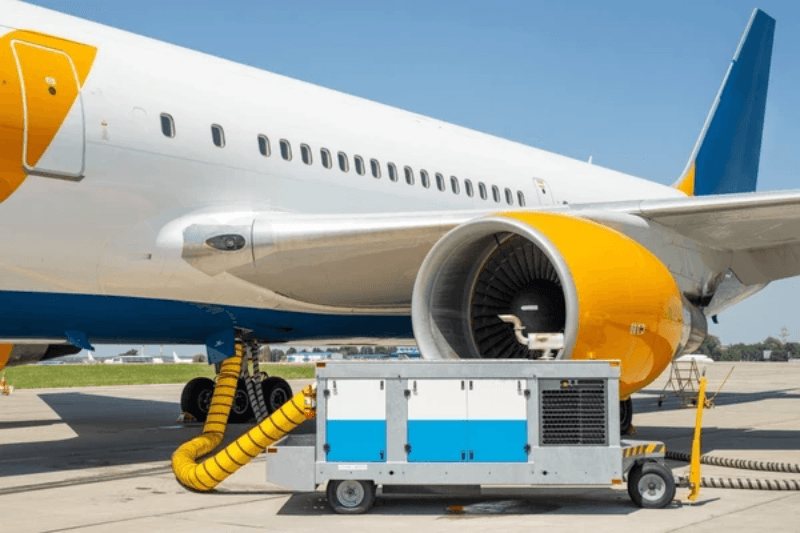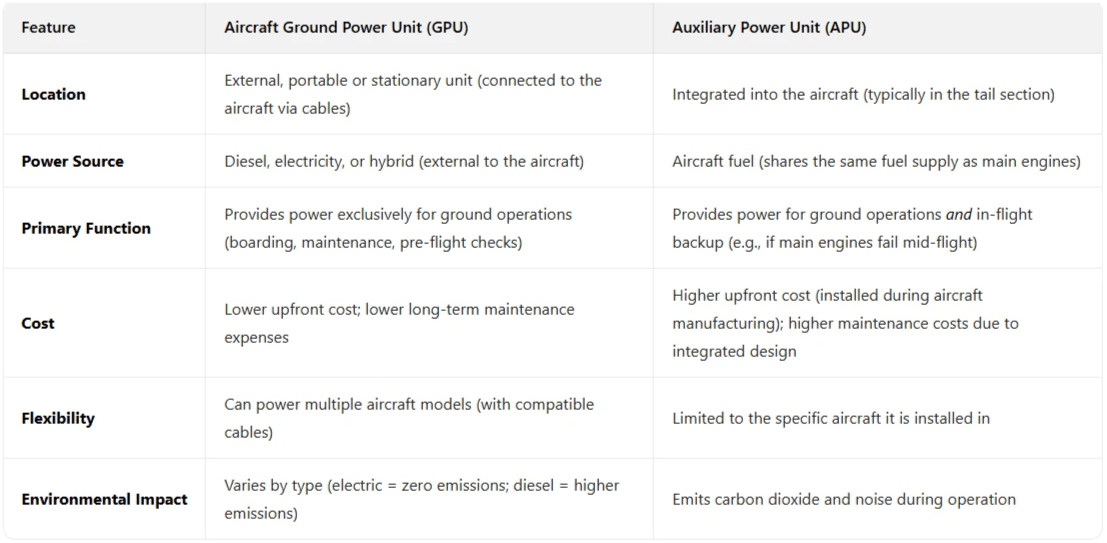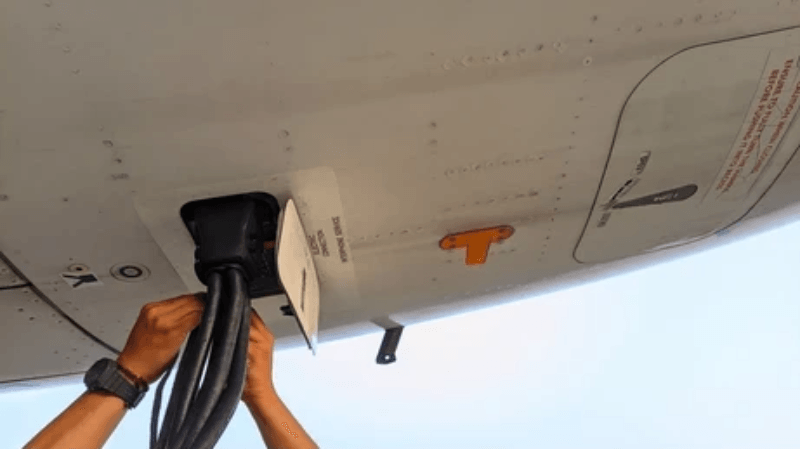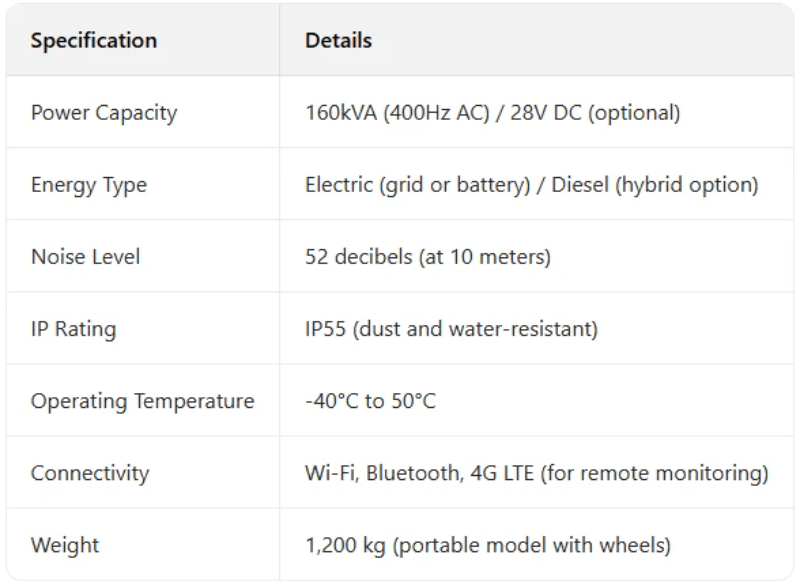In the dynamic landscape of aviation, an efficient
Aircraft Ground Power Unit (GPU) is not just a supporting tool—it’s a critical component that keeps ground operations running smoothly, safely, and cost-effectively. Every time an aircraft docks at a gate, undergoes maintenance, or prepares for passenger boarding, it relies on an Aircraft Ground Power Unit to supply consistent electrical power to vital systems, eliminating the need to drain the aircraft’s internal battery or waste fuel by running main engines. Choosing the wrong GPU can lead to costly delays, increased maintenance expenses, and even safety risks, while the right one enhances operational efficiency and delivers long-term value. This comprehensive guide will walk you through everything you need to know to select an Aircraft Ground Power Unit that aligns with your fleet’s needs, environmental goals, and budget—from understanding GPU basics to exploring top-tier models like Haisen’s industry-leading YC160DT.
Why Aircraft Ground Power Units Are Indispensable for Modern Aviation

Before diving into selection criteria, it’s essential to grasp why Aircraft Ground Power Units are non-negotiable for any aviation operation. When an aircraft is parked on the tarmac or in a hangar, its main engines are typically shut down to conserve fuel and reduce wear. Without an external power source like an Aircraft Ground Power Unit, critical systems such as cockpit avionics, cabin lighting, climate control, and pre-flight diagnostic tools would be rendered inoperative. This isn’t just a matter of convenience; it directly impacts passenger comfort (e.g., sweltering cabins in summer or freezing conditions in winter), crew productivity, and compliance with aviation safety standards.
Core Functions of an Aircraft Ground Power Unit
An Aircraft Ground Power Unit serves three primary roles that keep ground operations on track:
- Power Pre-Flight Operations: Pilots depend on GPUs to activate cockpit instruments for pre-flight checks—including testing navigation systems, communication tools, and flight controls—without starting the main engines. This not only saves fuel but also reduces engine wear, extending the lifespan of costly aircraft components.
- Maintain Cabin Comfort and Safety: During boarding and deplaning, an Aircraft Ground Power Unit keeps cabin climate control running, ensuring passengers and crew remain comfortable regardless of external weather. It also powers emergency lighting systems, which are critical for safety in case of unexpected incidents.
- Support Maintenance and Specialized Tasks: Maintenance teams rely on stable power from an Aircraft Ground Power Unit to conduct repairs, inspections, and system diagnostics. Many advanced GPUs also supply pneumatic pressure, which is used to start auxiliary systems or flush waste tanks before departure—eliminating the need for separate, costly equipment.
In short, an Aircraft Ground Power Unit is the backbone of efficient ground operations. It prevents delays, preserves aircraft integrity, and ensures compliance with industry regulations—making it a must-have investment for airports, maintenance facilities, and private aviation operators alike.

Types of Aircraft Ground Power Units: Which One Fits Your Needs?
Not all Aircraft Ground Power Units are designed the same way. The market offers several types, each tailored to specific operational requirements, environmental conditions, and aircraft sizes. Understanding the differences between these types is the first step in selecting an Aircraft Ground Power Unit that delivers optimal performance for your unique needs.
1. Diesel-Powered Aircraft Ground Power Units
Diesel-powered GPUs are known for their robust performance and high power output, making them ideal for large commercial aircraft (e.g., Boeing 787s, Airbus A350s) that demand significant electrical capacity. They are particularly valuable in remote locations or areas with limited access to electrical grids, as they operate independently of external power sources.
Key Advantages:
- High power density: Can deliver 400Hz AC power (the standard for aviation) to support heavy-duty systems in large aircraft.
- Durability: Built to withstand harsh weather conditions, including dust, rain, and extreme temperatures, making them suitable for outdoor use in diverse climates.
- Independence from grid power: Ideal for off-site maintenance yards, emergency response scenarios, or airports with unreliable electrical infrastructure.
Considerations:
- Higher emissions: Diesel engines produce carbon dioxide and noise, which may conflict with airport sustainability goals or local noise regulations (e.g., in residential areas near airports).
- Higher operational costs: Diesel fuel is more expensive than electricity, and these units require regular oil changes, filter replacements, and engine servicing.
2. Electric-Powered Aircraft Ground Power Units
Electric-powered GPUs are rapidly gaining popularity in modern aviation due to their low environmental impact and quiet operation. They run on electricity (either from the grid or rechargeable batteries) and are an excellent choice for airports with strict noise and emission standards, as well as facilities focused on sustainability.
Key Advantages:
- Zero emissions: Align with global carbon reduction targets (such as the aviation industry’s goal of net-zero emissions by 2050) and reduce environmental footprint.
- Quiet operation: Produce minimal noise (typically 40–50 decibels), making them suitable for airports near residential neighborhoods or noise-sensitive areas.
- Lower maintenance costs: Fewer moving parts than diesel models, eliminating the need for engine servicing, oil changes, or fuel filter replacements.
- Energy efficiency: Modern electric GPUs use smart technology to optimize power output, reducing energy waste and lowering operational costs over time.
Considerations:
- Dependence on grid or battery power: Requires access to a reliable electrical supply or regular battery recharging, which can be a limitation in remote locations.
- Capacity limitations: Some lower-power electric GPUs may not be suitable for the largest commercial aircraft, though advanced models (like Haisen’s high-capacity electric GPUs) now offer 400Hz output for heavy-duty use.
3. Hybrid Aircraft Ground Power Units
Hybrid GPUs combine the best of diesel and electric technology, offering flexibility for operations that require both high power and sustainability. They use a diesel engine to charge onboard batteries or generate power when needed, and switch to electric mode for low-noise, zero-emission operation in sensitive areas.
Key Advantages:
- Versatility: Suitable for mixed fleets (e.g., both small private planes and large commercial jets) and diverse operational settings (urban airports and remote maintenance yards).
- Balanced performance: Delivers high power output for large aircraft while maintaining quiet, emission-free operation in noise-sensitive zones.
- Backup power: The diesel engine serves as a backup during power outages or when battery levels are low, ensuring uninterrupted operation.
Considerations:
- Higher upfront cost: Hybrid technology is more complex, leading to a higher initial purchase price than single-type GPUs. However, this cost is often offset by long-term savings in fuel and maintenance.
- Moderate maintenance needs: Requires servicing for both diesel and electric components, though less than diesel-only units.
By selecting the right type of Aircraft Ground Power Unit, you’ll ensure that your operations are efficient, compliant with regulations, and aligned with your long-term sustainability and budget goals.
Aircraft Ground Power Unit vs. APU: Key Differences Every Operator Must Know
When it comes to powering aircraft on the ground, two terms are often confused: Aircraft Ground Power Units (GPUs) and Auxiliary Power Units (APUs). While both supply power to aircraft when main engines are off, they differ significantly in design, functionality, and cost. Understanding these differences is critical to deciding when to use each—and how to optimize your ground operations with an Aircraft Ground Power Unit.
Core Differences Between Aircraft Ground Power Units and APUs
The table below breaks down the key distinctions between an Aircraft Ground Power Unit and an APU:

When to Prioritize an Aircraft Ground Power Unit Over an APU
An Aircraft Ground Power Unit offers distinct advantages in several scenarios:
- Cost savings: APUs burn expensive aircraft fuel, while an Aircraft Ground Power Unit (especially electric models) uses cheaper electricity or diesel. Using a GPU can reduce fuel costs by up to 30% during ground operations.
- Extend APU lifespan: APUs have a limited lifespan (typically 10,000–15,000 hours) and are costly to repair or replace. Minimizing APU use with an Aircraft Ground Power Unit reduces wear and extends its operational life.
- Noise-sensitive areas: Electric GPUs operate quietly, making them ideal for airports near residential areas or during night operations when noise restrictions are stricter.
- Fleet flexibility: A single Aircraft Ground Power Unit can power multiple aircraft models (with the right cables), eliminating the need to invest in separate power solutions for each aircraft in your fleet.
When to Use an APU Instead of an Aircraft Ground Power Unit
APUs are more suitable in specific situations:
- Remote locations: In areas with no access to an Aircraft Ground Power Unit (e.g., emergency landings in remote areas or off-site maintenance), an APU provides essential power.
- In-flight backup: Unlike an Aircraft Ground Power Unit, APUs can supply power during flight if main engines fail, making them a critical safety feature.
- Long ground delays: If an aircraft is stuck on the tarmac for hours (e.g., due to weather or air traffic control issues), an APU can maintain cabin comfort without relying on external power.
By combining the use of an Aircraft Ground Power Unit and an APU strategically, you can maximize efficiency, reduce costs, and ensure safety—all while minimizing your environmental impact.

Critical Factors to Consider When Selecting an Aircraft Ground Power Unit
Choosing the right Aircraft Ground Power Unit requires more than just picking a type (diesel, electric, hybrid). You need to evaluate factors that align with your aircraft’s specifications, operational environment, and long-term goals. Below are the most important considerations to guide your decision.
1. Aircraft Ground Power Unit Price: Balancing Upfront Cost and Long-Term Value
Price is often the first factor operators consider, but it’s crucial to look beyond the initial purchase cost of an Aircraft Ground Power Unit. A cheap GPU may save money upfront but can lead to higher expenses over time due to frequent repairs, inefficient energy use, or early replacement.
Key Cost Considerations:
- Upfront cost: Electric Aircraft Ground Power Units typically have a higher initial price than diesel models, while hybrid units are the most expensive. However, electric models offer lower long-term costs due to reduced maintenance and energy expenses.
- Operational costs: Calculate fuel or electricity costs for your GPU. For example, a diesel Aircraft Ground Power Unit may cost $50–$100 per day in fuel, while an electric model could cost $10–$20 per day in electricity (depending on local rates).
- Maintenance costs: Diesel Aircraft Ground Power Units require regular engine servicing, oil changes, and filter replacements—costing $1,000–$3,000 per year. Electric models have minimal maintenance needs, with costs often 50% lower.
- Lifespan: A high-quality Aircraft Ground Power Unit can last 10–15 years. Investing in a durable model (even if it’s more expensive) avoids the cost of replacing a cheap GPU every 3–5 years.
When evaluating Aircraft Ground Power Unit price, ask suppliers for a total cost of ownership (TCO) analysis. This will help you compare models based on long-term value, not just upfront cost.
2. Compatibility with Your Aircraft Model
Using an incompatible Aircraft Ground Power Unit can damage the aircraft’s electrical systems, void warranties, or create safety hazards. Ensuring compatibility is non-negotiable.
Key Compatibility Checks:
- Voltage and frequency: Most commercial aircraft require 400Hz AC power, while smaller private planes or helicopters use 28V DC power. Ensure your Aircraft Ground Power Unit matches your aircraft’s voltage and frequency requirements.
- Power capacity: Calculate the maximum power your aircraft needs. For example, a small private jet may require a 20kVA Aircraft Ground Power Unit, while a large commercial jet needs a 90kVA–120kVA unit. Choosing a GPU with insufficient capacity will cause power shortages, while excess capacity wastes energy.
- Connector type: Aircraft use different connector types (e.g., NATO plugs, ANSI plugs, or proprietary connectors). Ensure your Aircraft Ground Power Unit comes with the right connectors for your fleet, or opt for a model with interchangeable cables to support multiple aircraft.
If you operate a mixed fleet, look for a versatile Aircraft Ground Power Unit that can adjust voltage, frequency, and power output to match different aircraft models.
3. Environmental and Operational Settings
The environment where you’ll use your Aircraft Ground Power Unit has a major impact on its performance and durability. Consider these factors:
- Weather resistance: If you operate in rainy, snowy, or dusty areas, choose an Aircraft Ground Power Unit with an IP (Ingress Protection) rating of IP54 or higher (protected against dust and water splashes). For extreme temperatures (e.g., -40°C to 50°C), look for GPUs with insulated components and temperature control features.
- Noise regulations: Airports near residential areas often have strict noise limits (e.g., 65 decibels during the day, 55 decibels at night). Electric Aircraft Ground Power Units are the quietest (40–50 decibels), while diesel models can be loud (70–80 decibels)—so check noise ratings before buying.
- Portability vs. stationary use: If you need to move the GPU between gates or hangars, choose a portable Aircraft Ground Power Unit with wheels and a lightweight design. For fixed locations (e.g., a dedicated maintenance bay), a stationary GPU (installed on the ground or a cart) is more durable and powerful.
- Grid access: If your facility has reliable access to the electrical grid, an electric Aircraft Ground Power Unit is ideal. For remote locations, a diesel or hybrid GPU is better, as it doesn’t depend on grid power.
By aligning your Aircraft Ground Power Unit with your environment, you’ll ensure it performs reliably for years to come.
Must-Have Features in a High-Quality Aircraft Ground Power Unit
In 2025, the best Aircraft Ground Power Units offer more than just power—they come with advanced features that enhance efficiency, safety, and user experience. Here are the key features to look for when selecting an Aircraft Ground Power Unit.
1. Performance Specifications
The performance of an Aircraft Ground Power Unit directly impacts its ability to support your aircraft’s needs. Focus on these specs:
- Stable power output: Look for an Aircraft Ground Power Unit with low voltage fluctuation (±1%) to protect sensitive aircraft electronics (e.g., avionics, navigation systems). Fluctuating power can cause system failures or data loss during pre-flight checks.
- Dual-voltage/frequency support: For mixed fleets, a GPU that switches between 400Hz AC (commercial jets) and 28V DC (small planes) eliminates the need for multiple units.
- High power density: Modern Aircraft Ground Power Units with high power density deliver more power in a smaller, lighter design—making them easier to move and store. For example, Haisen’s YC160DT offers 160kVA of power in a compact frame, ideal for busy airports with limited space.
2. Temperature Control Systems
Aircraft Ground Power Units operate in diverse climates, so temperature control is critical:
- Cooling mechanisms: Prolonged use can cause GPUs to overheat. Look for units with liquid cooling (more efficient than air cooling) or variable-speed fans that adjust to workload—reducing noise and energy use.
- Heating options: In cold climates, an Aircraft Ground Power Unit with built-in heaters prevents components from freezing. This is essential for reliable operation in areas like Alaska, Canada, or Northern Europe, where temperatures can drop below -30°C.
3. Energy Efficiency and Sustainability
With rising fuel costs and environmental concerns, energy efficiency is a top priority for any Aircraft Ground Power Unit:
- Smart load management: Advanced Aircraft Ground Power Units use smart technology to adjust power output based on the aircraft’s needs. For example, if the aircraft only needs power for lighting (not climate control), the GPU reduces output—saving energy and lowering costs.
- Renewable energy compatibility: Some electric Aircraft Ground Power Units can be paired with solar panels or wind turbines, allowing you to power them with clean energy. This aligns with sustainability goals and reduces reliance on the grid.
- Energy monitoring tools: Look for an Aircraft Ground Power Unit with built-in meters that track energy use. This data helps you identify inefficiencies (e.g., a GPU running at full capacity when it’s not needed) and optimize operations.
4. Safety and User-Friendly Features
Safety and ease of use are non-negotiable for any Aircraft Ground Power Unit:
- Overload protection: An Aircraft Ground Power Unit with overload protection shuts down automatically if power demand exceeds capacity—preventing damage to the GPU and the aircraft.
- Remote monitoring and control: Modern Aircraft Ground Power Units (like Haisen’s YC160DT) come with IoT connectivity, allowing you to monitor performance, adjust settings, and receive maintenance alerts via a smartphone or computer. This reduces the need for on-site checks and minimizes downtime.
- User-friendly interface: A clear control panel (with digital displays and intuitive buttons) reduces training time for operators. Look for an Aircraft Ground Power Unit with touchscreens or real-time data displays (e.g., power output, temperature, runtime).
These features don’t just make your Aircraft Ground Power Unit more efficient—they also improve safety, reduce downtime, and position your operation as forward-thinking in an industry increasingly focused on sustainability.
Spotlight on Haisen’s YC160DT: The Premier Aircraft Ground Power Unit for 2025
When it comes to reliable, efficient, and versatile Aircraft Ground Power Units, Haisen’s YC160DT stands out as a top choice for aviation operators worldwide. Designed to meet the demands of modern aviation, this Aircraft Ground Power Unit combines power, sustainability, and user-friendly features—making it a wise investment for long-term operational success.
Why the Haisen YC160DT Stands Out
- Unmatched Versatility: The YC160DT is compatible with nearly all commercial and private aircraft, from small regional jets to large wide-body planes (e.g., Boeing 777s, Airbus A380s). It supports both 400Hz AC and 28V DC power, eliminating the need for multiple Aircraft Ground Power Units.
- Exceptional Power and Efficiency: With a 160kVA power capacity, this Aircraft Ground Power Unit delivers steady, high-quality power for even the most demanding tasks (e.g., powering a commercial jet during a 4-hour maintenance check). Its energy-efficient design reduces electricity or fuel use by up to 25% compared to older GPU models—saving you thousands of dollars per year.
- Durable and Weather-Resistant: Built with a heavy-duty steel frame and an IP55 rating, the YC160DT withstands rain, dust, and extreme temperatures (-40°C to 50°C). This makes it ideal for use in any climate, from desert airports to Arctic maintenance yards.
- Smart Technology Integration: This Aircraft Ground Power Unit comes with Haisen’s proprietary IoT platform, which allows remote monitoring, predictive maintenance, and real-time energy tracking. For example, if the GPU’s cooling system needs service, you’ll receive an alert on your phone—preventing unexpected downtime.
Key Specifications of the Haisen YC160DT Aircraft Ground Power Unit

Why Aviation Professionals Trust Haisen for Aircraft Ground Power Units
Haisen has been a leader in ground support equipment for over 20 years, and their commitment to quality and customer satisfaction sets them apart:
- Industry Expertise: Haisen’s engineering team has deep experience in aviation, ensuring their Aircraft Ground Power Units meet the strictest safety and performance standards (e.g., ISO 9001, FAA, EASA certifications).
- Exceptional Customer Support: Haisen offers 24/7 technical support, global spare parts delivery, and on-site maintenance services for their Aircraft Ground Power Units. This means if your YC160DT needs service, you’ll get help quickly—minimizing downtime.
- Competitive Pricing: Despite its advanced features, the YC160DT is priced competitively compared to other high-end Aircraft Ground Power Units. Haisen also offers flexible financing options, making it easier to invest in a top-quality GPU without straining your budget.
Whether you’re an airport operator looking to upgrade your fleet of Aircraft Ground Power Units, a maintenance facility needing a reliable unit for daily repairs, or a private aviation company seeking to improve passenger comfort, the Haisen YC160DT delivers the performance, durability, and value you need.
Conclusion: Invest in the Right Aircraft Ground Power Unit for Long-Term Success
Choosing the right Aircraft Ground Power Unit is one of the most important decisions you’ll make for your aviation operation. An effective Aircraft Ground Power Unit reduces fuel costs, extends the life of your aircraft’s APU, prevents delays, and improves the passenger experience—all while aligning with your sustainability goals.
To recap, here’s how to make a wise selection:
- Understand Your Needs: Evaluate your aircraft type, operational environment, and long-term goals (e.g., cost savings, sustainability).
- Choose the Right Type: Select a diesel, electric, or hybrid Aircraft Ground Power Unit based on your power needs, environmental regulations, and grid access.
- Prioritize Compatibility: Ensure the Aircraft Ground Power Unit matches your aircraft’s voltage, frequency, and connector type to avoid damage or safety risks.
- Evaluate Cost Wisely: Look beyond upfront price—consider operational, maintenance, and replacement costs to calculate total value.
- Opt for Advanced Features: Choose an Aircraft Ground Power Unit with energy efficiency, smart monitoring, and temperature control to enhance performance and reduce downtime.
If you’re ready to invest in a high-quality Aircraft Ground Power Unit that meets all these criteria, the Haisen YC160DT is an excellent choice. With its versatility, efficiency, and durable design, it’s built to support your operations for years to come.
Ready to Upgrade Your Aircraft Ground Power Unit?
Contact Haisen today to learn more about the YC160DT and how it can transform your ground operations. Our team of aviation experts will help you assess your needs, provide a customized quote, and answer any questions you have about Aircraft Ground Power Units. Don’t wait—invest in an Aircraft Ground Power Unit that delivers value, reliability, and efficiency.

